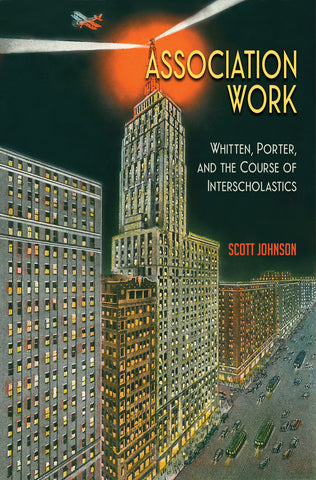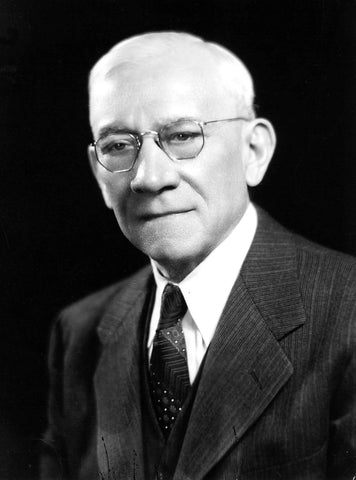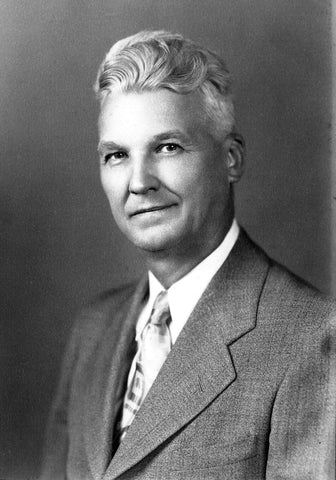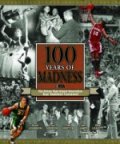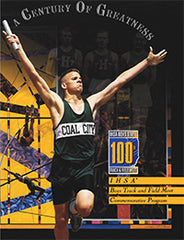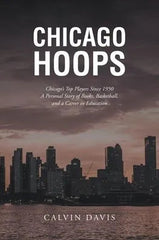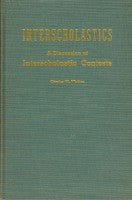Association Work: Whitten, Porter, and the Course of Interscholastics
Who set the stage for the modern world of high school sports?
C. W. Whitten and H. V. Porter were the two most influential men in the interscholastic movement in the first half of the 20th century. Working out of a small office suite in a downtown Chicago skyscraper, Whitten was the executive director of both the Illinois High School Association (IHSA) and the National Federation of State High School Associations (NFHS) until his retirement in 1942. Porter was Whitten's second-in-command at the IHSA, leaving in 1940 to become the first full-time director of the NFHS.
Association Work: Whitten, Porter, and the Course of Interscholastics, a new book recently published by the IHSA and the NFHS, commemorates the lives of the two men and takes a first-time look inside the world of interscholastic sports administration, recounting the many issues addressed and struggles endured by both men.
Early in his tenure Whitten was called upon to lead the fight against college sponsorship of high school events, pitting him against the University of Chicago and its famous football coach, Amos Alonzo Stagg, in a battle that held long-range implications for high school sports. Porter was the driving force behind the effort to write playing rules designed specifically for high school competition. He also spearheaded initiatives to develop the fan-shaped backboard and molded basketball, sparking a revolution in the manufacture of sports equipment.
In addition to those topics, the book covers Whitten's background as a college professor and later as principal at DeKalb High School, and Porter's career as principal and successful basketball coach at Athens High School. It also traces Porter's much-publicized connection to the magical phrase "March Madness," which ends with a surprising revelation.
Association Work was written by Scott Johnson, assistant executive director of the IHSA and co-author of Once There Were Giants (with his wife Julie Kistler) and 100 Years of Madness (with Curt Herron, Pat Heston, Jeff Lampe, and Bob Leavitt). Prior to its release, the book was distributed to delegates from the various state high school associations at the 99th Annual Meeting of the NFHS, held in Chicago from June 28 to July 2, 2018.
EXCERPTS
Chapter 8, "Champions All!"
Whitten and Stagg meet in 1930 to discuss the Federation's newly instituted ban on national basketball tournaments.
Although compromise seemed nearly impossible, Wilfred Smith was determined to use the Tribune poll to force a confrontation. After some negotiation he arranged for Stagg and Whitten to meet face-to-face at the Hotel Windermere, near the college campus, with Smith and Arch Ward in attendance. That morning, examining his dossiers, Stagg compiled a list of questions to put to Whitten in a last-ditch attempt to save his tournament. At the appointed hour he hustled to the hotel and up the stairs to the opulent Crystal Ballroom, where the climactic Stagg-Whitten summit got under way amid the clanking of tea service in the background. On one side of the table sat Amos Alonzo Stagg, a living legend, still remarkably spry at 67 years old, intent on stating his case one last time. On the other was C. W. Whitten, 58, a mostly anonymous "bureaucrat," slight of build and sporting wire-rimmed glasses, more than a little skeptical but willing to hear the coach out.
"Wouldn't it make more sense for each state association to decide for itself on participation in the national tournament?" the coach asked. Stagg felt the National Federation was "clubbing athletic institutions into line" with its policy and creating an undignified spectacle. Whitten parried the attack by reminding Stagg that ultimately it was up to each individual state association to enforce the ban. Stagg tried another approach. "Can the secondary schools really get along without the colleges?" he asked. Yes, they can, Whitten assured Stagg. He added that while state associations might need help in hosting certain large meets or tournaments, going forward they insisted on having full authority over high school competition. Stagg scribbled in the margin of his notebook: "Whitten wants to manage and control all high school events." Lunch interrupted the interrogation and the four men exchanged pleasantries. Then, as the meeting drew to a close, Stagg posed an existential question he thought Whitten might never have considered: "What purpose will the Federation have if interstate interscholastic meets are done away with?" Smith missed his chance to preserve Whitten's answer for posterity, but one thing is certain: in this card game Whitten held all the aces. The meeting was cordial — Whitten found Stagg "as always, a genial and courteous gentleman" — but it ended with no movement on either side as the men went their separate ways to await the result of the University of Chicago's special investigation.
Chapter 13, "If They Have Brains Enough"
State high school associations are spurred to write their own football rules in 1932.
The high school men who made it their mission to formulate a new set of football rules knew the work would not be easy. Of all codes of sport, football's was the most complex. In contemplating the task, they again took their inspiration from the words of Knute Rockne, although they were not about to win one for the Gipper. In his letter to P. F. Neverman, director of the Wisconsin association, Rockne had asked whether it was true that the National Federation men, "suddenly cognizant of their importance and along with the natural craving for power," were about to write their own football rules. "Not that I see anything against this providing you have anybody in your personnel who knows anything about these things." Rockne's dismissive comment emerged as a rallying cry among the Federation men, transforming into even more derogatory variants as time passed. C. W. Whitten recalled it as, "If they are capable of it." To H. V. Porter it became, "If they have brains enough."
After the NCAA ousted the high school representatives from its rules committees, Porter jumped to accept Rockne's challenge. Rallying member school principals and state association executives to the cause, he published a manifesto in the February 1932 edition of the Illinois High School Athlete, concluding:
It is now the time for action. The National Collegiate Athletic Association considered the matter of asking high schools to name several representatives to serve on the football rules committee. The proposal was voted down. We do not object to that action. They evidently desire to make rules for their own group without any interference from others. This is just and right. The same thing applies to the high school group. They should make the rules for their own 20,000 or more members.
The Athlete, without qualification, recommends that they proceed immediately with this work.
Chapter 16, "Leave Your Noise Making Machines at Home"
Porter documents the scene at the 1933 IHSA state basketball tournament.
Hoping to preserve a time capsule of the tournament, Porter brought his movie camera to Champaign to film some of the goings-on. On Friday the only session was held in the evening, so during the day the Whitten and Porter scheduled conferences with principals, coaches, and others in attendance. In the morning Porter worked with Hugh Ray at the headquarters hotel to hammer out some language for the new edition of the Federation's football rule book. A little later he stopped by a conference room where members of the Board of Control were treated to a demonstration of a fanciful "electric basketball indicator" that set off flashing lights attached to the top of a miniature backboard when a ball dropped through the hoop. Developed by a local inventor named William Ukanavage, the contraption had a fanciful name: the Bask-O-Lite. A group of basketball coaches stopped by the room a little later to test the bounce and feel of the new Dubow ball being marketed with the Federation imprint. After lunch it was time for some fun, and Porter and several board members walked to the University's brand-new ice rink in their three-piece suits to show off their skill at figures, with varying degrees of success. Then it was over to Memorial Stadium to toss a pigskin around the lawn prior to the annual meeting of high school football coaches. Porter recorded it all with his camera before heading to Champaign High School to watch the teams practice for the semifinals.
The star of the 1933 tournament was a young sharpshooter from Thornton Township High School named Lou Boudreau, the future baseball Hall of Famer. Thornton's coach, Jack Lipe, was a proponent of the running style of play, a novelty in the days of the center jump. The high scores racked up by his squad had captivated the public and the press, who called them the "Flying Clouds." Porter had been following the team all year long and wanted to get a closer look. Their drills were like nothing he had seen at the high school level — a series of cuts to the basket and quick passes that contrasted with the most common strategy, which consisted of a dozen or more passes around the perimeter followed by 25-foot shot. Porter pointed his camera at the skinny, dark-haired Boudreau, who smiled, turned toward the basket, and effortlessly sank a two-handed shot from belt level. In the tournament, Boudreau's play was phenomenal. At one point he unleashed a behind-the-back pass, leaving his defender tied in knots and setting up an easy layup by a teammate. Porter was awestruck by Boudreau's ballhandling, which he described as "positively thigmotropic," a scientific word describing a plant that coils around a solid object. He recounted the amazement of opposing coaches at the "whirling dervish pivots, fakes, passes, and shots" of the Thornton squad as it sliced its way through the tournament field. The championship game against Springfield, the best of the "slow-break" teams, ended with Thornton on top, 14 to 13 — a disappointingly low-scoring battle that was counted as a victory for the running game nevertheless.
REVIEWS
I strongly recommend that any institution that has a general sport history course, the library should be notified that Association Work is an essential addition to their collection. Historians will be consulting Johnson’s outstanding book for many decades hence. — Robert Pruter at Sport in American History
Johnson's rendition of the growth of the IHSA and National Federation and his inclusion of the roles of the administrative pioneers fills a void in the history of interscholastic sports in the United States. It is well researched, well written, and should be of interest to sports fans as well as sports historians. — Prof. Gerald R. Gems in Journal of Illinois History

